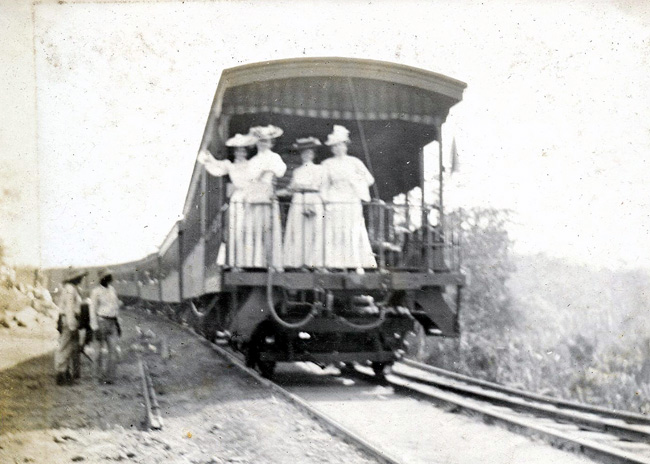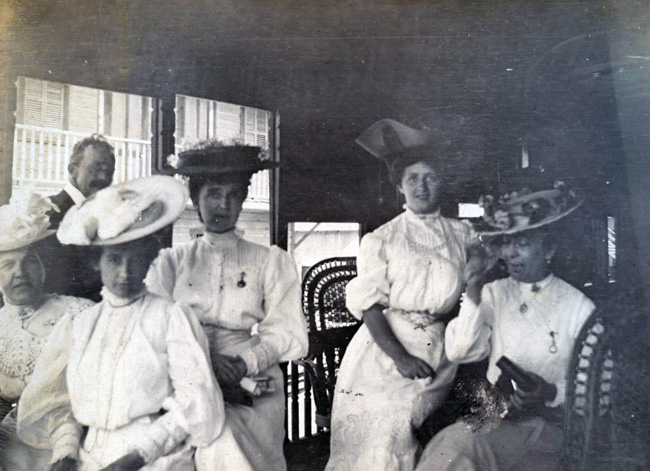 |
Photo of the Week
October 9, 2011
 |
|
This
weeks photos are taken at from what I believe could be the departure
of Lilian from Panama. I could be wrong, but the captions on
some of the photos may indicate the day of departure. The photo
above has a caption "Saying
Good-bye at Camp". They are on the back platform of
Governor Magoon's (see below bottom photo) private rail car.
This rail car is seen in other famous photos with President Roosevelt
standing on this same platform when visiting the Canal Zone. The
photo below shows the same group sitting inside the car. Lilian
is the the second from the right. Was Fred the
photographer? Not sure. Another similar photo in the
collection has a caption stating, "Homeward
bound from
As
always...super great photos and truly great captures of
the times back in 1906. |
 |
|
From Wikipedia PanamaIn late 1903, Secretary Root announced that he was retiring as secretary of war. Speculation followed in the media that Magoon would retire simultaneously and join the outgoing secretary in private practice.[9] Instead, Magoon was appointed by President Theodore Roosevelt in June 1904 to be the general counsel for the Isthmian Canal Commission, the group working toward what would eventually become the Panama Canal. In this role, he would be working under Chairman John G. Walker, but would not be a commissioner.[10] According to President Roosevelt, Magoon deserved the position because he had "won his spurs" working in the War Department and was well respected.[3] Although Magoon was working for the Canal project, his office and residence remained in Washington, DC. On March 29, 1905, President Roosevelt unexpectedly called for the simultaneous resignations of all members of the Canal Commission and the governor of the Panama Canal Zone, George Whitefield Davis.[11] According to Secretary of War William Howard Taft, this clean sweep was due to the "inherent clumsiness" of the Commission, especially as related to sanitary problems in the Zone, as well as the difficulty of reaching consensus between the current seven commissioners.[12] Several days later, replacement appointments were announced: Magoon was appointed both governor and a member of the Commission, with railroad entrepreneur Theodore P. Shonts made chairman of the Commission.[13] The new Commission had seven commissioners, as required by the act of Congress that created the body, but responsibilities were to be split such that only Magoon, Shonts, and the chief engineer had any real authority. The remaining four members of the commission were appointed only to fulfil the letter of the law. Congress had already rejected a request by the President to formally make the Commission a three-member body; restructuring the organization was an end-run by the President around that restriction.[12] In order to assume his new duties, Magoon relocated to the Canal Zone the following month. Governor of Panama Canal ZoneThe Panama Canal Zone Magoon's primary responsibilities within the Canal Zone were to improve sanitation and to deal with the all-too-common outbreaks of yellow fever and malaria. At first, he refused to believe that the diseases were carried by mosquitos because, he reasoned, the native population would have been more affected. At this time, the nature of human acquired immunity to diseases was not well understood. The Chicago Tribune, in an article about conditions in the canal, referred to the notion that yellow fever was carried by mosquitos as "bugaboo".[14] However, by January 1906, Magoon had long come to understand the role of misquitos in the transmission of dieases, as evidenced in a New York Times article wherein Magoon addressed criticisms of his administration in detail; by then he had undertaken a vigorous and ambitious plan to eliminate the swamps that bred misquitos.[15] While governor, he worked with translators in the War Department to publish an English edition of the complete Civil Code of Panama, which he codified as the law of the Canal Zone on May 9, 1904. This was the first time that the complete civil code of a Spanish-speaking country not a U.S. territory had been translated into English. It was significant that he did not make changes to these laws when "importing" them into the legal system of the territory that he governed.[16] On July 2, 1905, President Roosevelt further consolidated power in Panama by appointing Magoon Minister to Panama, to replace John Barrett. This put Magoon in the unique position of being both a governor of a U.S. territory and a diplomat to the country of which that territory was an enclave. During the tenure of Governor Davis, there had been friction between him and Minister Barrett. This double appointment would ensure that the two roles could not work at cross-purposes. Magoon would draw two salaries in the arrangement, an issue which would come up later to haunt him. With influential posts in both Panama proper and the Canal Zone, Magoon was an exceptionally powerful man on the Isthmus.[17]
|
Home|
Photo
of the Week | Photo
Archives | Main
Show Room | Photo
Room | Military
History
PC
History | Sign
Guest Book | Read
Guest Book | Search
CZ Images | CZ
Web Searcher
Gift
Shop | Links
